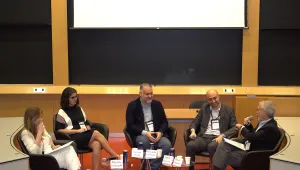Recent research in economics shows how not to design climate treaties—and suggests how to get it right.
The UN approach to climate negotiations is to focus on emission reduction. It is well recognized that research and development (R&D) and new green technology will be essential, but the investment choices are and will be left to sovereign countries.
The caveat with this approach is the so-called hold-up problem in economics: After a country has invested in green technology, it will be requested to cut emissions more, because, when technology investments have already been made, it is both efficient and fair that the deepest cuts are made in the country where cuts are least expensive.1
Countries thus have little incentive to invest in green technologies if yet another round of climate negotiations is coming up. In fact, if the duration of the commitment period is just a few years, then green investments can be lower in the presence of climate agreements than they would have been in their absence. For this reason, countries can actually be worse off with treaties of short duration than with no treaties at all.2 To encourage more investment, it is important that the commitment-periods are long-lasting, particularly when technology is seen to be an important part of the solution to greenhouse-gas emissions, or if R&D is likely to be sub-optimally low for other reasons (such as weak protection of intellectual property rights).
The traditional argument against long-term commitments is uncertainty: we do not yet know how much it is appropriate to pollute fifty years from now. The best way of updating climate agreements is not by simply letting them expire, however, but by renegotiating them. If countries sign commitments that are designed to remain in force indefinitely, unless all signatories accept modifications later on, then we can achieve both flexibility and investment.3
Note that international trade agreements seldom have expiration dates, but they are frequently renegotiated over time. With regard to climate, we therefore have something to learn from how we negotiate trade treaties.
So, is the solution necessarily a long-lasting commitment to quantified emission cuts? The answer would be yes if the treaty was signed by all countries. If many countries decide to opt out, however, it will be inefficient to lock-in a relatively small "coalition of the willing." A small coalition is better off with a shorter-duration agreement, since one can then hope that other countries will join later.
And here lies the key to a larger coalition: The short duration preferred by a small coalition will, as explained above, reduce countries' incentive to invest in green technology. This reduction in investments harms everyone, including the countries opting out. Countries may thus think twice when the ultimate consequence of opting out is smaller investments in all countries.4
With this effect, countries are discouraged from opting out, or, equivalently, encouraged to participate if they anticipate that a smaller coalition will decide on shorter commitment periods. For this positive effect to manifest, it is clearly important that the duration of the commitment period can be determined after it is clear how large the coalition will be.
Note
The analysis and results above are summarized in the following publication of the Harvard Project on Climate Agreements. This material is now accepted for publication in the three academic journals listed in the footnotes.
Bård Harstad, "Treaty Design and Duration: Effects on R&D, Participation, and Compliance," Viewpoints, January 2013. http://belfercenter.ksg.harvard.edu/publication/22707.
See also the following closely related Harvard Project publications by Bård Harstad:
"How to Negotiate and Update Climate Agreements," Discussion Paper 08-19, November 2008. http://belfercenter.ksg.harvard.edu/publication/18676.
"Rules for Negotiating and Updating Climate Treaties," Viewpoints, August 27, 2009. http:// belfercenter.ksg.harvard.edu/publication/19535.
"The Dynamics of Climate Agreements," Discussion Paper 09-28, July 2009. http://belfercenter.ksg. harvard.edu/publication/19489.
1The New York Times reported that "Leaders of countries that want concessions say that nations like Denmark have a built-in advantage because they already depend more heavily on renewable energy" ("European Nations Seek to Revise Agreement on Emissions Cuts," October 17, 2008).
2Bård Harstad, "The Dynamics of Climate Agreements," Journal of the European Economic Association, published online June 4, 2015.
3Bård Harstad, "Climate Contracts: A Game of Emissions, Investments, Negotiations, and Renegotiations," Review of Economic Studies, 2012, Vol. 79 (4), pp. 1527–1557.
4Marco Battaglini and Bård Harstad, "Participation and Duration of Environmental Agreements," Journal of Political Economy, forthcoming 2015. An earlier version of this paper is available at: www.sv.uio.no/econ/personer/vit/ bardh/dokumenter/participation.pdf.
Bård Harstad Department of Economics, University of Oslo; Ragnar Frisch Centre for Economic Research
Viewpoints present policy proposals, considered opinions, and commentary by distinguished policymakers, leaders from business and non-governmental organizations, and scholars. The Harvard Project on Climate Agreements does not advocate any specific climate-change policy proposals. Statements and views expressed in Viewpoints are solely those of the authors and do not imply endorsement by Harvard University, the Harvard Kennedy School, or the Harvard Project on Climate Agreements.
Harstad, Bard. “Designing Climate Treaties: Technological Innovation and Duration of Commitment.” Harvard Project on Climate Agreements, Belfer Center, July 2015





